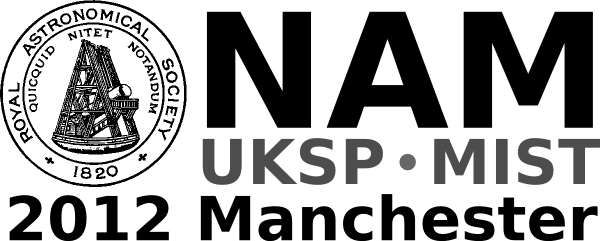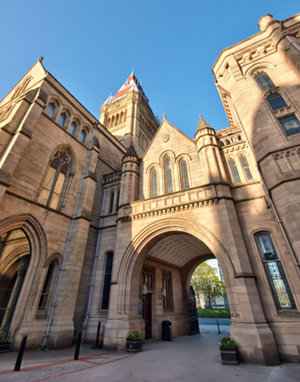UK-Germany National Astronomy Meeting NAM2012
Huge tornadoes discovered on the Sun
Royal Astronomical Society press release
RAS PR 12/ 23 (NAM 14)
29 March 2012
Solar tornadoes several times as wide as the Earth can be generated in the solar atmosphere, say researchers in the UK. A solar tornado was discovered using the Atmospheric Imaging Assembly (AIA) telescope on board the Solar Dynamic Observatory (SDO) satellite. A movie of the tornado will be presented at the National Astronomy Meeting 2012 in Manchester on Thursday 29th March.
"This is perhaps the first time that such a huge solar tornado is filmed by an imager. Previously much smaller solar tornadoes were found my SOHO satellite. But they were not filmed," says Dr. Xing Li, of Aberystwyth University.
Dr. Huw Morgan, co-discover of the solar tornado, adds, "This unique and spectacular tornado must play a role in triggering global solar storms."
The AIA saw superheated gases as hot as 50 000 - 2 000 000 Kelvin sucked from the root of a dense structure called prominence, and spiral up into the high atmosphere and travel about 200 000 kilometres along helical paths for a period of at least three hours. The tornadoes were observed on 25 September 2011.
The hot gases in the tornadoes have speeds as high as 300,000 km per hour. Gas speeds of terrestrial tornadoes can reach 150km per hour.
The tornadoes often occur at the root of huge coronal mass ejections. When heading toward the Earth, these coronal mass ejections can cause significant damage to the earth's space environment, satellites, even knock out the electricity grid.
The solar tornadoes drag winding magnetic field and electric currents into the high atmosphere. It is possible that the magnetic field and currents play a key role in driving the coronal mass ejections.
SDO was launched in February 2010. The satellite is orbiting the Earth in a circular, geosynchronous orbit at an altitude of 36,000 kilometres. It monitors constantly solar variations so scientists can understand the cause of the change and eventually have a capability to predict the space weather.
IMAGES AND ANIMATIONS
Stills and animations of the solar tornado can be downloaded from: http://users.aber.ac.uk/xxl/tornado.htm
The tornado was observed with the AIA telescope on board NASA's Solar Dynamic Observatory. Credit: NASA/SDO/AIA/Aberystwyth University/Li/Morgan/Leonard
MEDIA CONTACTS
NAM 2012 Press Office (0900 - 1730 BST, 27-29 March; 0900 - 1630 BST 30 March)
Room 3.214
University Place building
University of Manchester
Manchester
UK
Tel: +44 (0)161 306 7313
Dr Robert Massey
Royal Astronomical Society
Mob: +44 (0)794 124 8035
Email: rm@ras.org.uk
Anita Heward
Royal Astronomical Society
Mob: +44 (0)7756 034 243
Email: anitaheward@btinternet.com
Dr Klaus Jaeger
Pressereferent / Press Officer im Vorstand der Astronomischen Gesellschaft
Tel: +49 6221 528 379
Email: pressereferent@astronomische-gesellschaft.de
Dan Cochlin
Media Officer (Faculty of Engineering and Physical Sciences)
University of Manchester
Tel: +44 (0)161 275 8387
Email: daniel.cochlin@manchester.ac.uk
SCIENCE CONTACTS
Dr Xing Li
University of Aberystwyth
Tel: 01970 621 542
Email: xxl@aber.ac.uk
Dr Huw Morgan
University of Aberystwyth
Tel: 01970 622810
Email: hmorgan@aber.ac.uk
NOTES FOR EDITORS
NAM 2012
Bringing together more than 900 astronomers and space scientists, the National Astronomy Meeting (NAM 2012) will take place from 27-30 March 2012 in the University Place conference centre at the University of Manchester in the UK. The conference is a joint meeting of the Royal Astronomical Society (RAS) and the German Astronomische Gesellschaft (AG) and is held in conjunction with the UK Solar Physics (UKSP: www.uksolphys.org) and Magnetosphere Ionosphere Solar Terrestrial (MIST: www.mist.ac.uk) meetings. NAM 2012 is principally sponsored by the RAS, AG, STFC and the University of Manchester.
The Royal Astronomical Society
The Royal Astronomical Society (RAS: www.ras.org.uk), founded in 1820, encourages and promotes the study of astronomy, solar-system science, geophysics and closely related branches of science. The RAS organises scientific meetings, publishes international research and review journals, recognizes outstanding achievements by the award of medals and prizes, maintains an extensive library, supports education through grants and outreach activities and represents UK astronomy nationally and internationally. Its more than 3500 members (Fellows), a third based overseas, include scientific researchers in universities, observatories and laboratories as well as historians of astronomy and others.
The Astronomische Gesellschaft (AG)
The Astronomische Gesellschaft (AG: www.astronomische-gesellschaft.de), founded in 1863, is a modern astronomical society with more than 800 members dedicated to the advancement of astronomy and astrophysics and the networking between astronomers. It represents German astronomers, organises scientific meetings, publishes journals, offers grants, recognises outstanding work through awards and places a high priority on the support of talented young scientists, public outreach and astronomy education in schools.
The Science and Technology Facilities Council
The Science and Technology Facilities Council (STFC: www.stfc.ac.uk) is keeping the UK at the forefront of international science and tackling some of the most significant challenges facing society such as meeting our future energy needs, monitoring and understanding climate change, and global security. The Council has a broad science portfolio and works with the academic and industrial communities to share its expertise in materials science, space and ground-based astronomy technologies, laser science, microelectronics, wafer scale manufacturing, particle and nuclear physics, alternative energy production, radio communications and radar. It enables UK researchers to access leading international science facilities for example in the area of astronomy, the European Southern Observatory.
Jodrell Bank Centre for Astrophysics
The Jodrell Bank Centre for Astrophysics (JBCA: www.jb.man.ac.uk) is part of the School of Physics & Astronomy at the University of Manchester. JBCA is split over two main sites: the Alan Turing Building in Manchester and the Jodrell Bank Observatory in Cheshire. At Jodrell Bank Observatory, the new Jodrell Bank Discovery Centre is a key focus for our work in public engagement and education. Jodrell Bank is a world leader in radio astronomy-related research and technology development with a research programme extending across much of modern astrophysics. The group operates the e-MERLIN national radio astronomy facility and the iconic Lovell Telescope, hosts the UK ALMA Regional Centre Node and is home to the international office of the SKA Organisation. Funded by the University, the Science & Technology Facilities Council and the European Commission, it is one of the UK's largest astrophysics research groups.





